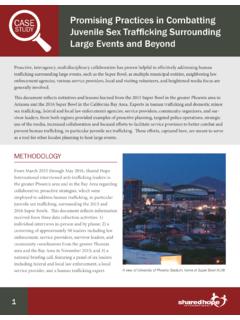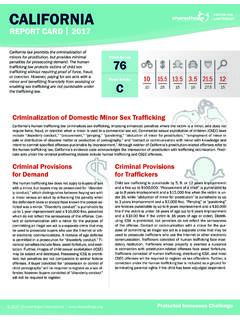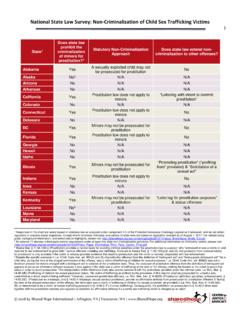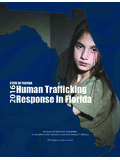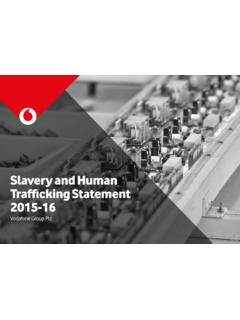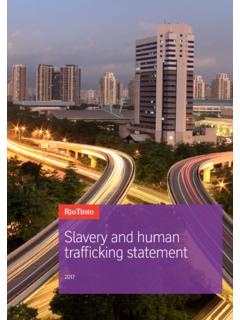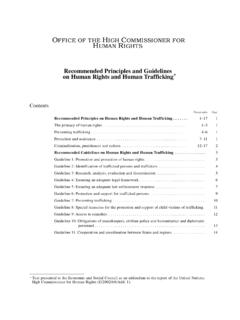Transcription of By: Linda A. Smith Samantha Healy Vardaman
1 : Linda A. SmithSamantha Healy VardamanMelissa A. SnowThe National Report on Domestic Minor Sex Traffi cking : America s Prostituted Children Smith Vardaman SnowJ15509 1J15509 15/26/09 4:23 PM5/26/09 4:23 PMThe National Report on Domestic Minor Sex Traffi cking : America s Prostituted ChildrenMay 2009 Shared Hope InternationaliiAll rights reserved. No part of this book may be reproduced in any manner without the written permission of Shared Hope International, except in the case of brief quotations used in connection with critical articles and and text art by J. David Ford & Associates, Hurst, TX 2009 Shared Hope InternationalPrinted in the United States of Hope Box 65337 Vancouver, WA 98665 Shared Hope International1501 Lee Highway, Suite 101 Arlington, VA National Report on Domestic Minor Sex trafficking : America s Prostituted ChildreniiiTABLE OF CONTENTSE xecutive Summary.
2 IvIntroduction .. 1 Chapter 1 Domestic Minor Sex Traffi cking .. 4 Chapter 2 The Business of Domestic Minor Sex Traffi 16 Chapter 3 Vulnerability .. 30 Chapter 4 Recruitment and Pimp Control .. 37 Chapter 5 Identifi cation of Domestic Minor Sex Traffi cking Victimsand Trauma Bonds .. 41 Chapter 6 Lack of Justice for the Victims of Domestic MinorSex Traffi cking .. 50 Chapter 7 Shelter and Services .. 67 Chapter 8 Next Steps .. 74 Shared Hope InternationalivExecutive SummaryDomestic minor sex traffi cking (DMST) is the commercial sexual exploitation of American children within borders. It is the recruitment, harboring, transportation, provision, or obtaining of a person for the purpose of a commercial sex act where the person is a citizen or lawful permanent resident under the age of 18 The age of the victim is the critical issue there is no requirement to prove force, fraud, or coercion was used to secure the victim s actions.
3 In fact, the law recognizes the effect of psychological manipulation by the traffi cker, as well as the effect of threat of harm which traffi ckers/pimps use to maintain control over their young DMST includes but is not limited to the commercial sexual exploitation of children through prostitution, pornography, and/or stripping. Experts estimate at least 100,000 American juveniles are victimized through prostitution in America each year. Domestic minor sex traffi cking is child sex slavery, child sex traffi cking , prostitution of children, commercial sexual exploitation of children (CSEC), and rape of a Hope International fi rst actively addressed the sex traffi cking of American children through research on the markets that create demand for commercial sex and which result in the commercial sexual exploitation of women and girls.
4 The DEMAND. Project investigated buyers, facilitators, and traffi ckers in four countries: Jamaica, Japan, the Netherlands, and the United States. The startling fi ndings highlighted the fact that sex traffi cking is demand-driven and the product for sale is most commonly local (domestic) children. Dedicated to ending the human rights violation of sex traffi cking internationally and domestically, Shared Hope International received a grant from the Department of Justice to perform fi eld research on domestic minor sex traffi cking the commercial sexual exploitation of American children in the United that strategic responses to sex traffi cking require comprehensive understanding of the local situation, Shared Hope International aligned with the Department of Justice-funded human traffi cking task forces to assess domestic minor sex traffi cking and the access to victim services in ten locations:1.
5 Dallas, TX2. San Antonio, TX3. Fort Worth, TX4. Salt Lake City, UT5. Buffalo, NY6. Baton Rouge and New Orleans, LA7. Independence, MO8. Las Vegas, NV9. Clearwater, FL10. The Commonwealth of the Northern Mariana Islands ( Territory)The assessment process investigated the three areas of Prevention, Prosecution, and Protection ( three Ps ) as the key components necessary to effectively combat traffi cking in persons. The assessments involved qualitative interviews of professionals likely to come into contact with victims of domestic minor sex traffi cking , as well as quantitative data collection when available. Seven professional groups were identifi ed as likely to come into contact with victims of domestic minor sex traffi cking and targeted for interviews: Federal, State, and Local Law Enforcement; Federal and State Prosecutors; Juvenile Court; Juvenile Probation and Detention; Public Defenders; Child Protective Services; and Social Services/Non-Governmental Organizations.
6 A total of 297 interviews were conducted. Statistics were requested but were not always available. In many cases, statistics I Traffi cking Victims Protection Act (TVPA) of 2000, Pub. L. No. 106-386, Division A, 103(8), (9), 114 Stat. 1464 (signed into law on October 29, 2000); codifi ed as amended at 22 USC 7102 103(8), (9). docid= Accessed on April 8, Id. at 1591(b)(2).The National Report on Domestic Minor Sex trafficking : America s Prostituted Childrenvprovided did not disaggregate data on domestic minor sex traffi cking a term and crime most interviewees were not familiar with yet; in these cases the statistics were reviewed for extrapolation in determining numbers of suspected domestic minor sex traffi cking victims. For example, juvenile detention facility statistics refl ecting numbers of youth detained under charges of prostitution could be properly counted toward the number of domestic minor sex traffi cking victims in that facility as juveniles in prostitution are victims of sex traffi cking under the federal Traffi cking Victims Protection Act of 2000 (TVPA).
7 The reliance on extrapolated data refl ects the glaring lack of identifi cation of domestic minor sex traffi cking victims and highlights the need for training as well as data collection on this victim population. Each assessed location produced information that was documented in an area-specifi c report, including information on the scope of the problem, how victims of domestic minor sex traffi cking were accessing the system, how they were being labeled, and, as a result of that label, how victims of domestic minor sex traffi cking were accessing or being barred from accessing services as victims of a violent crime. The fi ndings from the 10 site assessments, research studies, and fi eld work are the foundation for this National Report on the Identifi cation and Response to America s Traffi cked Youth.
8 Substantiation of the fi ndings was gained through Shared Hope International s National Training Conference on the Sex Traffi cking of America s Youth held September 15-16, 2008, in Dallas, Texas, which brought together nearly 200 fi rst responders from across the nation to share their experiences and best practices for responding to domestic minor sex traffi cking . Also, experts on the trauma and services required to counteract the trauma endured provided guidance in forming best practices in this fi key fi ndings of the study can be grouped into four components of domestic minor sex traffi cking : identifying the victims; prosecuting the traffi ckers; combating demand; and providing protection, access to services, and shelter for victims. 1. Misidentifi cationShared Hope International found misidentifi cation of the victims to be the primary barrier to the rescue and response to domestic minor sex traffi cking victims.
9 This misidentifi cation occurs at all levels of fi rst responses from law enforcement arrest on the streets to homeless and runaway youth shelters intake process, to court adjudication of the victim as a delinquent for habitual runaway or drug possession, or other offense occurring as a result of the prostitution of the child. Misidentifi cation causes a chain reaction of negative outcomes. It is responsible for the failure to deliver the necessary services to interrupt and treat the trauma they have endured. It is often the cause of their adjudication as delinquents or criminalization as adult offenders of prostitution, leading to detention and/or a criminal record with resulting lack of access to victim of crime funds. Misidentifi cation can be remedied only through awareness and education of fi rst responders and the community at large to properly identify the indicators of domestic minor sex traffi cking and to respond with the appropriate treatment and approach developed by experts in the specifi c trauma caused by traffi cking .
10 2. Criminalization of the Victim through Misidentifi cationVictims of domestic minor sex traffi cking are frequently processed as juvenile delinquents or adult prostitutes. Prostituted juveniles are trained by their traffi cker/pimp to lie to authorities and are provided with excellent fraudulent identifi cation resulting in their registration in the arrest records as an adult an identifi cation that follows them through their years as a minor unless and until it is corrected by the insight of a law enforcement offi cer who recognizes the victim is a minor and pursues a correct identifi cation. Law enforcement cited this problem as a barrier to identifying a child sex traffi cking victim. Those victims who are identifi ed as minors are frequently charged with a delinquent act either for prostitution-related activities or for a related offense, such as drug possession or habitual runaway.
